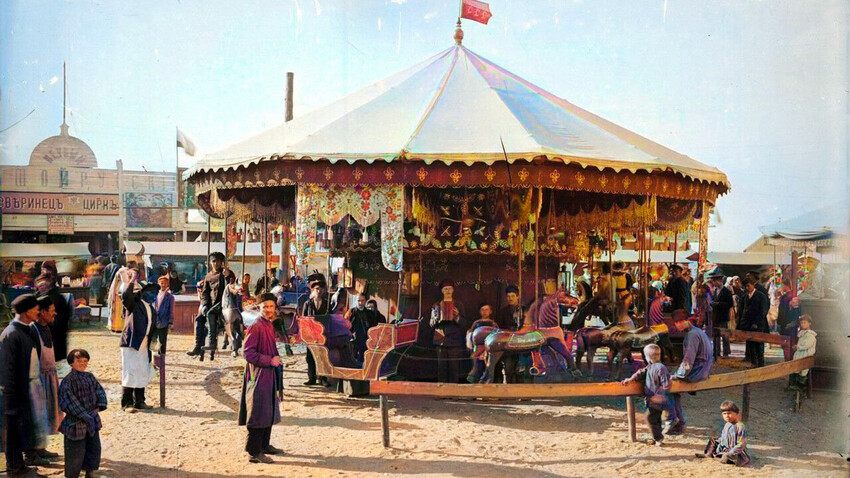
A merry-go-round at the Nizhny Novgorod fair, the 1900s
Maxim Dmitriev/The Archive for Audio and Video documents of Nizhny Novgorod oblastThe word ‘yarmarka’ (‘trading fair’ in Russian) came from German (‘Jahr’ – ‘year’, ‘markt’ – ‘market’) and it happened only in the 17th century, when German-speaking merchants began to trade with the Muscovy Tsardom. They brought in European fashion for the annual sales in the “lively” places – in large cities and at the intersections of major trade routes. Professional traders from different places and villages gathered at such fairs.
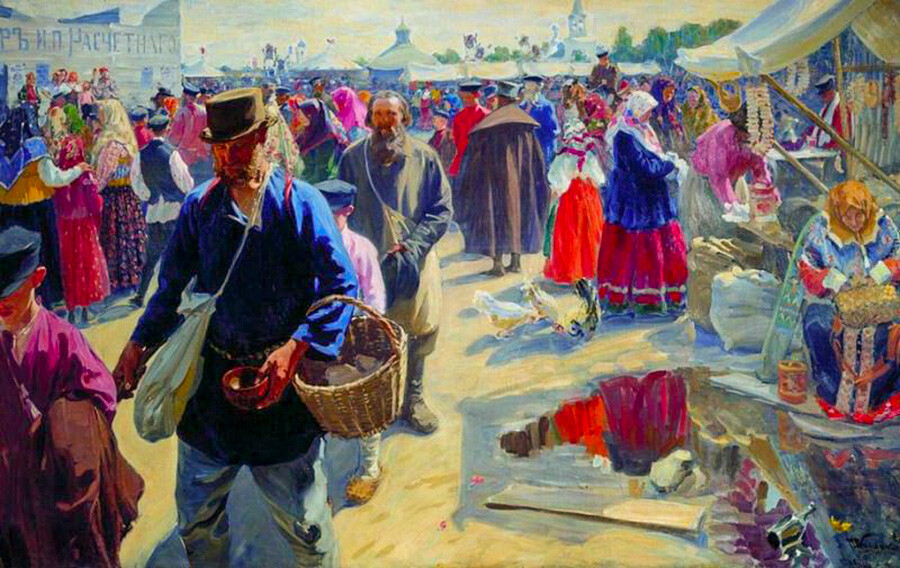
"The Murom fair," by Ivan Kulikov, 1910-1912
Murom History and Art MuseumIn the Russian state, the places where people gathered and exhibited goods for sale were called ‘torg’ (up to the 17th century, the Red Square in Moscow was called ‘Torg’, with a capitalized ‘T’). But, in most Russian cities, there were ‘torzhoks’ (i.e. small ‘torgs’) and bazaars. These were not yet ‘yarmarkas’!
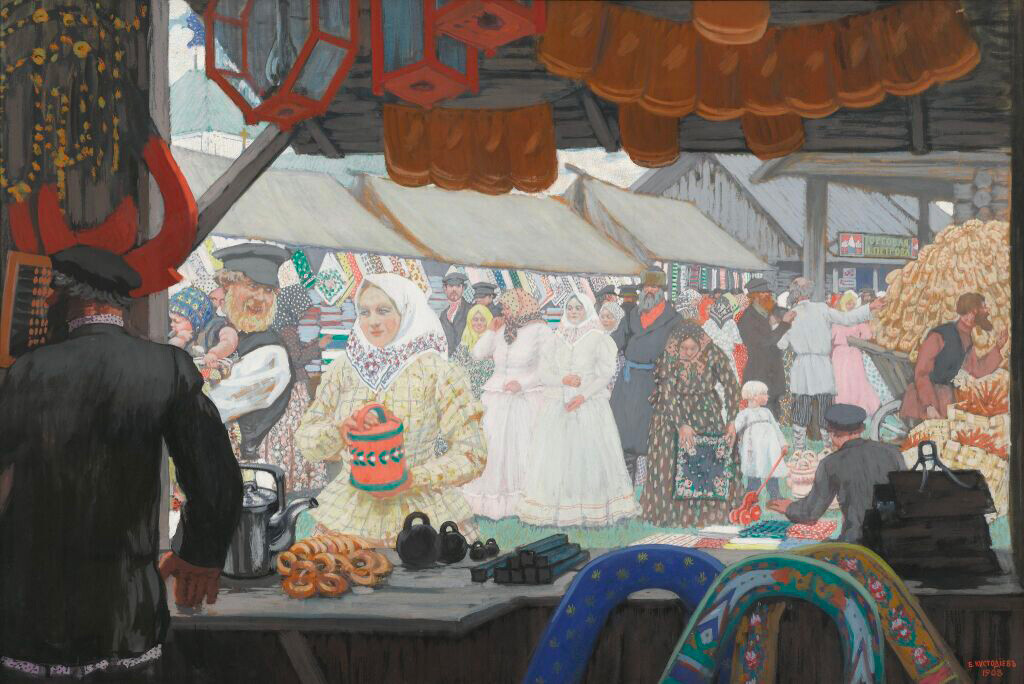
"Fair" by Boris Kustodiev, 1906
Tretyakov GalleryTypically, fairs were regular and gathered traders from all over, while torgs were local, with varying regularity. But, the first major trading places in Russia, which were, in fact, fairs, continued to be called torgs up to the 17th century – ‘Molozhsky Torg’, ‘Makarievsky Torg’.
Local traders traded at the torgs that gathered several times a year, and local bazaars were organized every week.
But, in the 14th century, Molozhsky Torg appeared on the river Mologa near the village of Borisoglebskoye (now flooded by the Rybinsk Reservoir). The Molozhskiy Torg was regular – about four summer months (from June to September or from May to August – depending on the weather and other factors) each year.
READ MORE: 5 things the Brits DISCOVERED from the Russians
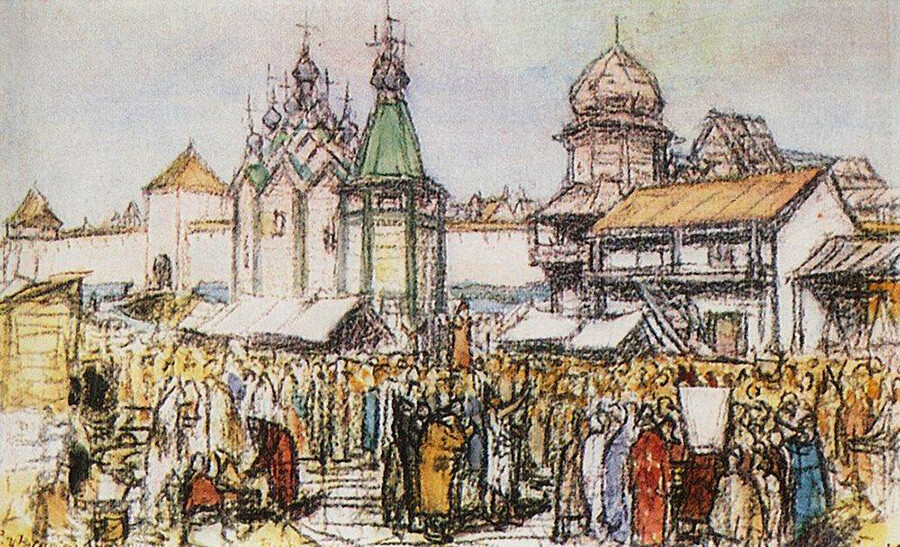
The torg near the Moscow Kremlin by Apollinary Vasnetsov
Museum of History and Reconstruction of MoscowPeople of all nationalities including Germans, Poles, Greeks, Armenians, Persians, Italians, Turks, traded here, and money wasn’t the main means of exchange. More often, those merchants traded goods for goods – for example, rare European weapons or expensive Arabian clothes were traded for Siberian furs, honey, caviar, and so on. There were so many ships arriving at the Molozhsky Torg that they dammed the entire Volga, not less than 500-600 meters wide, so that it was possible to cross from one bank to the other.
And, by the end of the 16th century, the main trade was near Nizhny Novgorod.

The plan for the Nizhny Novgorod trading fair, 1821
Public domainThe first large fair in Russia was ‘Makarievskaya’, that is, ‘Makarievsky Torg’, named after the Zheltovodskiy Makariev Monastery. Back then, the fair was located near it, roughly 90 kilometers from Nizhny Novgorod and, at the beginning of the 19th century, it moved to Nizhny Novgorod, where new modern pavilions were built for it.
It originally appeared in the middle of the Volga Route, between the confluence of the Oka and Kama rivers. In 1552-1556, Ivan the Terrible subjugated Kazan and Astrakhan, taking possession of the Volga trade route - merchants from the North were attracted to the southern lands, as Ivan Vasilievich allowed trade with Persia.
In addition to ‘Makarievskaya Fair’, there were also fairs in Irbit, Perm, Orenburg, Barnaul, as well as many others of smaller scale. In 1864, more than 18 thousand fairs with a turnover of more than one billion rubles were held (for comparison, the revenue part of the budget in 1866 was 362 million 475 thousand 811 rubles).
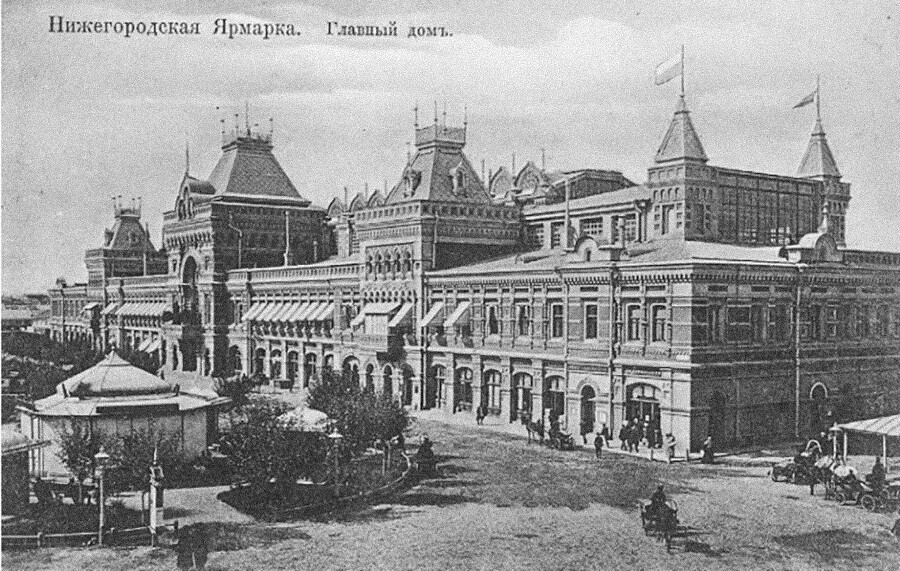
The stone buildings of the Nizhny Novgorod trading fair, early 20th century
Public domainAny torg or bazaar was not just a place of trade. It was, first of all, a public place, an area for entertainment, self-expression and advertising and, in this, it was similar to the ancient agoras and modern shopping centers.

"Rayok," a Russian fairground peep show, used a box with pictures viewed through magnifying lenses. The show was accompanied by lewd rhymed jokes told by the rayok operator. "Rayok" was one of the most popular attractions at the Russian fairs.
Public domainFor example, at the Molozhsky Torg, there were over 70 taverns and any fair was a place where you could drink away everything, including your clothes! People drank and enjoyed the performances of traveling artists and clowns. There were puppeteers, bear shows, as well as cock and goose fights. At a fair or a torg, one could get a haircut, get fully dressed, buy a horse, a cart and even find some love for sale.
If using any of Russia Beyond's content, partly or in full, always provide an active hyperlink to the original material.
Subscribe
to our newsletter!
Get the week's best stories straight to your inbox